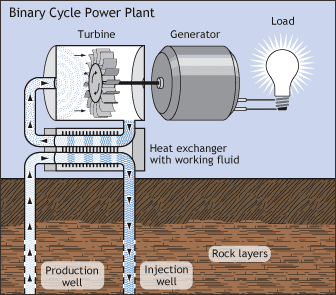I. I will be writing about Geothermal Energy use as an alternative source of energy. I will be researching this topic because it is important to be aware of alternative energy sources. Geothermal energy could be a vital source of energy that can be incredibly useful in the near future. The two audiences I will be presenting to are those who state that geothermal plants are environmentally friendly and may aid the environment, and the other stating that geothermal plants lead to air and thermal pollution.
II. Geothermal energy is an alternative source of energy in which heat from the planet can be used to generate steam through a steam turbine.
a. What's it used for?
1. District heating
2. Space heating
3. Industrial processes
4. Desalination applications
5. Agricultural applications
b. How its used
1. Production of electricity from geothermal energy sources
2. Three types of plants used to produce geothermal energy
a. Dry steam
b. Flash
c. Binary
III. Issues associated with geothermal energy
a. Environmental friendliness
b. Sustainability
c. Availability
d. Cost
e. Reliability
IV. Is geothermal energy environmentally friendly?
a. Much controversy over whether geothermal energy is harmful towards the environment.
b. Pros
1. Using geothermal energy reduces acid rain by 97%
2. Renewable, the energy is capable of cooling and heating homes without affecting the environment
3. Geothermal plants are small in scale, therefore reducing the impact of power plants on the environment
4. Minimum channels are required to channel geothermal energy through a power plant, therefore making the process efficient
c. Cons
1. Locating a site for trapping geothermal energy requires a place where hot rocks in the earth's crust can provide heat
2. Drill sites are not easily available or accessible, meaning the use of geothermal energy is hampered
3. The use of geothermal energy results in the emission of gases such as hydrogen sulfide, which rises to the surface along with the heated water
4. Land stability and trace pollution concerns from enhanced geothermal systems where water is injected into hot rocks
V. Geothermal energy is becoming more popular, but comes with pollution issues
a. Geothermal energy is especially attractive to smaller countries
b. Impacts of air and water pollution, subsidence, noise, and odors
c. Hazardous waste can be devastating to the environment, and is seen as an unwanted but necessary evil
VI. This topic is important because we are coming to the end of fossil fuel use as a energy source. We need to explore new options of energy use, and geothermal energy may be the ticket. The audiences I am trying to reach are important because they represent the two main groups behind either supporting or criticizing the use of geothermal energy. I would like to create a visual representation to reach my two audience groups by comparing the pros and cons of geothermal energy use. This is effective because by weighing out all the pros and cons, one can decide if geothermal energy use is worthwhile or not.
VII. Conclusion
a. Geothermal energy is seen as an efficient alternative energy source with some hazardous affects on the environment
1. Some of the affects aid the environment, while the pollution and other hazardous materials harm it
b. Do the affects on the environment outweigh the cost and exploration of new areas where geothermal energy can be obtained?
Bibliography
Source #2: Axtmann, R.C. "Environmental Impact of a Geothermal Power Plant." Science 187.4179 (1975): 795-97. Print.
Source #3: Dukert, Joseph M. Energy. Westport, CT: Greenwood, 2009. Print.
Source #7: Nersesian, Roy L. Energy for the 21st Century: a Comprehensive Guide to Conventional and Alternative Sources. Armonk, NY: M.E. Sharpe, 2007. Print.
Source #8: Robertson, D., E. Crecelius, J. Fruchter, and J. Ludwick. "Mercury Emissions from Geothermal Power Plants." Science 196.4294 (1977): 1094-097. Print.
Source #9: Sabadell, Eleonora J. "Heavy Metal Contamination From Geothermal Sources." Environmental Health Perspectives 12 (1975): 1-7. Print.
Source #10: Simon, Christopher A. Alternative Energy: Political, Economic, and Social Feasibility. Lanham, MD: Rowman & Littlefield, 2007. Print.



